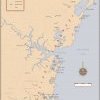North-coastal Sydney Aboriginal history
The area covered by the ‘North Coastal’ part of the website is, broadly, Wyong to Kirribilli and from the coast, west to the valley of the Lane Cove River. One reason is that this represents the areas where the language now often referred to as ‘Guringai’ was spoken in 1788. It was a big area, and while there were several regional variations merging into other languages, everyone would have understood one another. Of course other languages like Daruk, Darkinyung and Awabakal were spoken in the region as well.
Another reason is a historical one. After the terrible smallpox plague soon after the arrival of the First Fleet, the northside Koori population reduced enormously – some estimates put it at only ten per cent remaining. This meant that by 1795 the north side of the Harbour was almost empty of its Koori inhabitants.
Meanwhile an adventurous young man named Bungaree, who probably was born north of Broken Bay, was becoming familiar with the colonists. He went exploring with Matthew Flinders, he knew some of the Sydneysiders and he seemed to have liked the bustling life of the town. In about 1800 he made camp near Kirribilli and brought some of his extended family down from the north to the Harbour. They must have liked what they saw too, and Kirribilli become one of their many regular camps or stopping places.
This meant that the influence of Bungaree and his large family made itself felt over the north and south of Broken Bay - the same area where the Guringai language was spoken.
That’s the same area that we recognise today as ‘Guringai language country’, and the area covered by the North Coastal part of the website A History of Aboriginal Sydney.
What languages were spoken in this region?
In 1892 the ethnographer John Fraser used the term ‘Kuringgai’ for a ‘nation’ which he showed extending along the coast north of Sydney Harbour. He said the name Kuring-gai meant ‘men’. Tracey Howie, 2010 Chairperson of the Guringai Link Aboriginal Corporation, relates that ‘Wannungini is our traditional name’.
In 1940 the anthropologist Norman Tindale gave the name ‘Kamaraigal’ as the name of the tribe (not the language) in the Sydney area. In the 1960s the linguist Arthur Capell believed, partly through studying a language list provided by Bungaree’s son Long Dick, that there was a separate northside language which he said, was convenient to call Kuringgai. Kuringgai (Guringai) was spoken ‘on the north side of Port Jackson, east of the Lane Cove River to the coast, and as far north as Wyong and Tuggerah Lake, merging into ‘Awaba’.
This the area covered in this history, and on the map.
Since the 1970s archaeologists and anthropologists working in the Sydney region have adopted Capell’s names for the linguistic groups, with some amendments.
The archaeologist Val Attenbrow concludes her discussion of Sydney clan names and languages by noting how the widespread use of these present day language names by Aboriginal communities is a common way of maintaining local identity and affiliation with land over areas that incorporated more than one clan estate, especially in Sydney where the original land-based entities such as tribes who had responsibilities for clan estates have not survived. Their descendants still live in many parts of the region. (Attenbrow 2003, pp. 33-35)
Let’s remember that Aboriginal culture was not and is not static but keeps on evolving and changing with time. We will never know all the names as they were spoken by Koori people in 1788. What we have now is fragments, some in Aboriginal oral history and some in European interpretation. Knowledge as we currently know it is a mixture of both. To be sure of linguistic ‘correctness’ is a fanciful idea.
As in other areas of Australia, several Aboriginal languages were spoken within a single area. In the northern part, the most common language spoken after Guringai, was Darkinyung, and in the west of our area, Daruk would have been heard and mostly understood.
Most people believe that the language which we now call Guringai was the language most commonly spoken in the area covered by the map.
Guringai History:Read Guringai History
Calls for action to end 'Guringai' identity fallacy:'Guringai' identity fallacy

